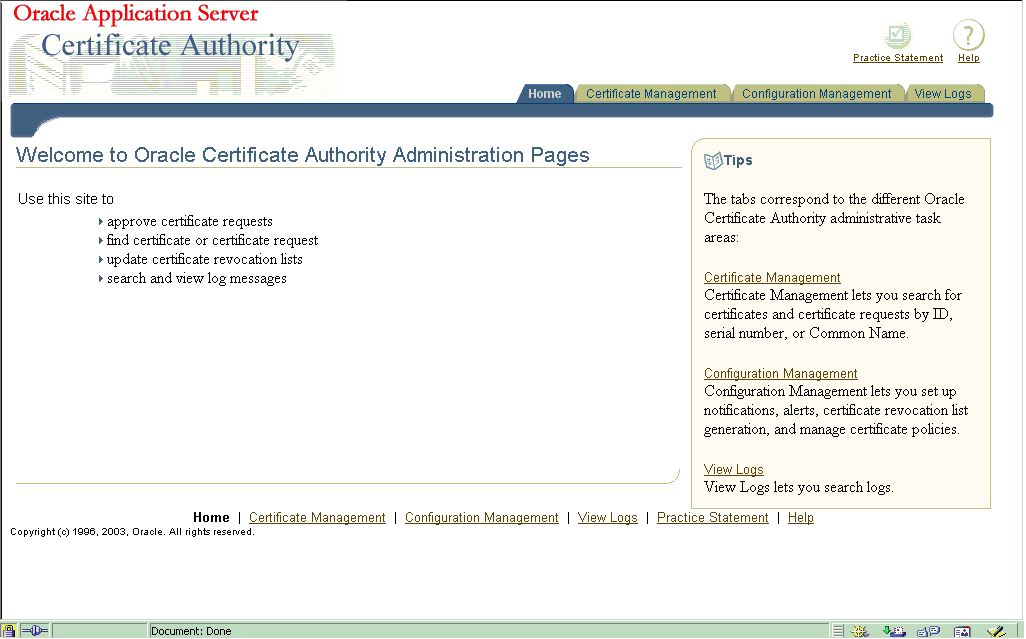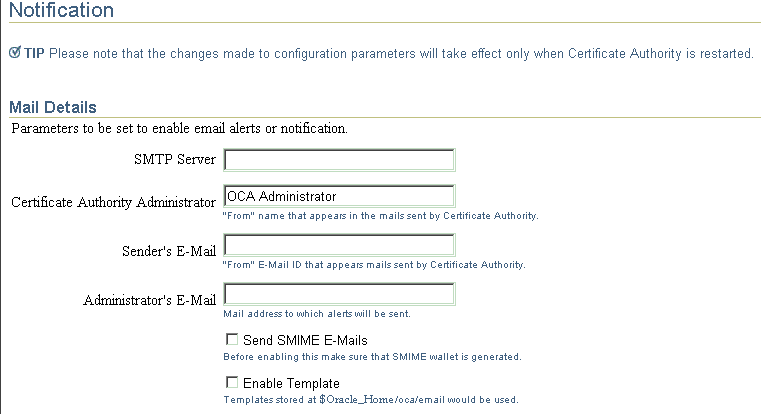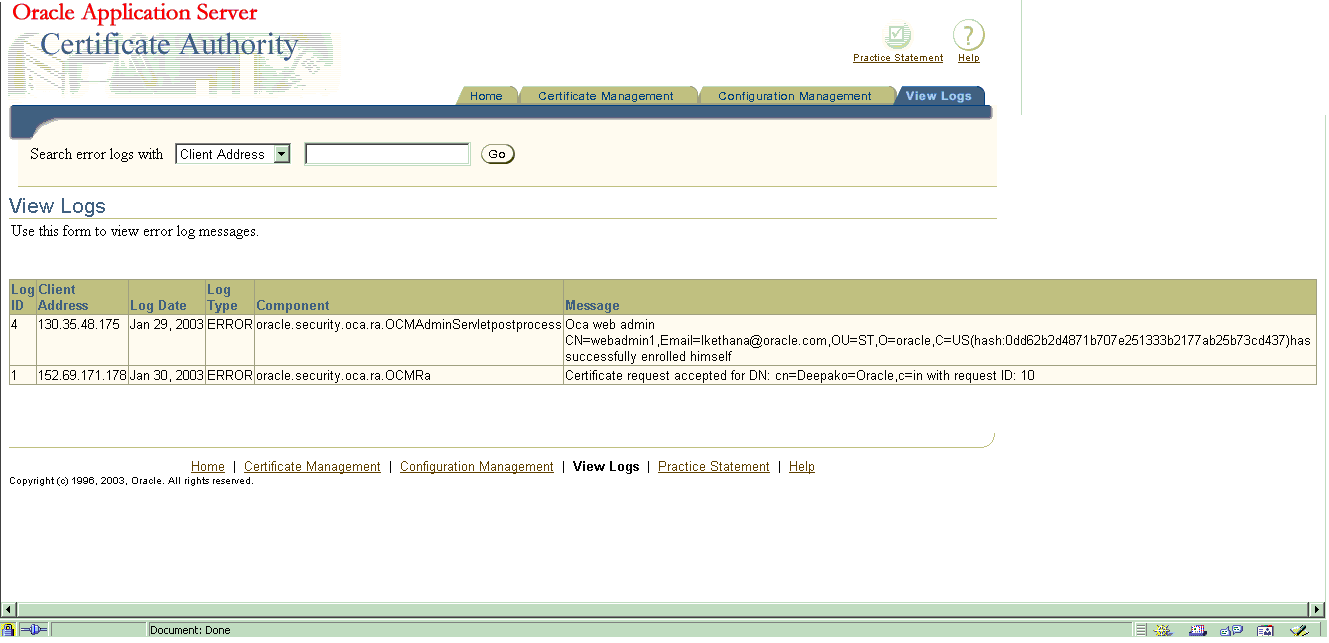10g (9.0.4)
Part Number B10663-01
Home |
Solution Area |
Contents |
Index |
| Oracle® Application Server Certificate Authority Administrator's Guide 10g (9.0.4) Part Number B10663-01 |
|
The Oracle Application Server Certificate Authority administrative web interface covers the following three broad areas, each accessible from a tab on the home page:
This chapter describes the second and third of those areas: configuration management and viewing logs, as well as describing the content you should provide in your certification practice statement.
It contains the following sections:
The home page of the graphical user interface (GUI) for Oracle Application Server Certificate Authority presents three additional tabs, as the following figure shows:

These three subtabs enable you to address specific tasks in managing certificates or the Certificate Authority configuration:
The Configuration management tab is one of the four choices available when you first enter the Oracle Application Server Certificate Authority web environment. Clicking the Configuration Management tab on the home page displays the first of the three subtabs, each representing a grouping of the Oracle Application Server Certificate Authority configuration management facilities.
The content and use of those subtabs are explained in the following sections:
Table 4-1, Table 4-2, and Table 4-3 list the tasks encompassed by the Notification, General, and Policy sub-tabs of Configuration Management and provide links to discussions of those tasks.
| Notification Sub-tab Tasks and Data | Links to Task Discussions |
|---|---|
|
Specify server name and email contacts for alerts and notifications. Specify desired types of alerts. Specify the interval between generating CRLs, the interval between validating CRLs, and the interval between directory synchronizations |
| General Sub-tab Tasks and Data | Links to Task Discussions |
|---|---|
|
Specify that certificate publishing uses SSL or non-SSL communication channel with Oracle Internet Directory. |
|
|
Specify that end-users can use SSL and SSO authentication for certificate management. |
|
|
Specify logging, tracing, both, or neither. |
|
|
Specify default values for DN components shown in enrollment. |
|
|
See configuration parameters for the database and directory. |
| Policy Sub-tab of Oracle Application Server Certificate Authority Tasks and Data (in Chapter 5) | Links to Task Discussions |
|---|---|
|
See the policies applicable to available operations, such as certificate requests, revocations, or renewals. Edit, enable, disable, delete, add, or reorder policies. |
Notification parameters control what events trigger notification emails to the administrator, how those emails are generated, and how often checking is done to reveal such events.
Changes you make to Notification configuration parameters will take effect only after Oracle Application Server Certificate Authority is restarted.
Mail parameters enable email notifications to be sent, encrypted or clear, to the email address you specify for the administrator and to the OCA users when appropriate, using your specified server, sender, and template. You specify your choices in the following portion of the Notification subtab screen:

Note that the hint below Enable Template will, after installation, display the exact path to the template directory. For example, if $Oracle_Home is defined during installation as /private/sitename/username, then this hint will display as "Templates stored at /private/sitename/username/oca/email."
Alerts parameters enable you to specify whether you are to receive alerts in the following circumstances:
You specify your choices in the following portion of the Notification subtab screen:

Scheduled Jobs parameters enable you to make the following choices about automatic jobs:
You specify your choices in the following portion of the Notification subtab screen:

Text description of the illustration notifnscheduledjobs.gif
This sub-tab enables you to set parameters controlling the following tasks:
Changes you make to General configuration parameters will take effect only after Oracle Application Server Certificate Authority is restarted.
The choices in this section enable you to publish certificates to the directory and to choose SSL protection for messages that tell the directory about those certificates.

The choices in this section let you specify that SSL or SSO users can be recognized automatically, meaning that their existing certificates (or SSO authentication) are accepted as authenticating their identities. Enabled by default, such acceptance means Oracle Application Server Certificate Authority will issue them a new certificate without administrator intervention.

The choices in this section let you specify whether to create a log file of all user activities, a tracing file of all details for every error, or both.

Logs are stored in the OCA repository; you can view them from the View Logs tab. Trace is stored on the file system, in the file at $ORACLE_HOME/oca/logs/oca.trc.
The values you fill in here will be used to pre-fill some of the Distinguished Name elements on the manual enrollment request form used to submit certificate requests.

This facility is simply for the users' convenience, supplying common fields. The values you fill in here can be overridden as needed.
The settings shown here simply tell you the database connect string that is being used to connect to the Oracle Application Server Certificate Authority repository.

These settings only change if Oracle Application Server Certificate Authority's repository moves to a new location. You can use the ocactl updateconnection command in that case to update the repository connection settings.
The settings shown here simply tell you the host, agent, and port being used to connect with Oracle Internet Directory.

This configuration management page enables you to view logs that record messages regarding transactions or errors occurring during use of Oracle Application Server Certificate Authority. Such a screen would look like this:

Each line of such a log contains six elements, beginning with a log id number, the IP address that initiated the client activity, and the date of the action. Each line also includes the log entry type, the component of Oracle Application Server Certificate Authority generating the entry, and the component's message about the activity.
A certification practice statement describes the policies and procedures your site and certification authority follow, and thus often contains the following information:
You can add or alter your certification practice statement (CPS) by editing the $ORACLE_HOME/oca/help/Help/oca_cps.html file.
After Oracle Application Server Certificate Authority is restarted, your changes will appear on the Practice page when any user clicks the Practice Statement icon appearing on every page.
Certificate Practice Statements described by the OCA administrator using the above procedure is not internationalization (i18n) compliant. That means, the clients in a different language than the OCA server language will see the practise statement in server's language only."
|
|
 Copyright © 2002, 2003 Oracle Corporation. All Rights Reserved. |
|